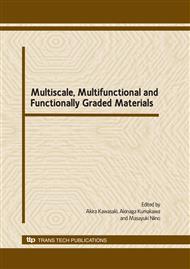p.199
p.205
p.211
p.217
p.225
p.231
p.239
p.245
p.253
Advanced Nanostructure-Controlled Functionally Graded Materials Employing Carbon Nanotubes
Abstract:
Capability of multiwalled carbon nanotubes (CNTs) to create in-depth gradients in properties and functionalities of conventional materials has been investigated for the first time. Functionally graded material (FGM) concept has also been employed for the first time to bridge conventional materials to their advanced nanocomposites containing a high concentration of CNTs, which is promising for unexplored yet novel structural, electronic and biomaterial applications. In this study, α-alumina ceramics considered as the most challenging case has been used as the matrix. Bulk, layered, nanostructure-controlled, CNT-based, functionally graded α-alumina ceramics have been fabricated employing a recently established powder processing technology. In-depth gradients in microstructure, grain size and hardness have been successfully achieved in alumina ceramic without cracking, delamination or warping, after homogeneous and gradual incorporation of the CNTs within the alumina ceramic matrix. The FGM approach showed promise to successfully bridge conventional ceramics to their nanocomposites containing a high concentration of CNTs.
Info:
Periodical:
Pages:
225-230
Citation:
Online since:
October 2009
Authors:
Price:
Сopyright:
© 2010 Trans Tech Publications Ltd. All Rights Reserved
Share:
Citation:


